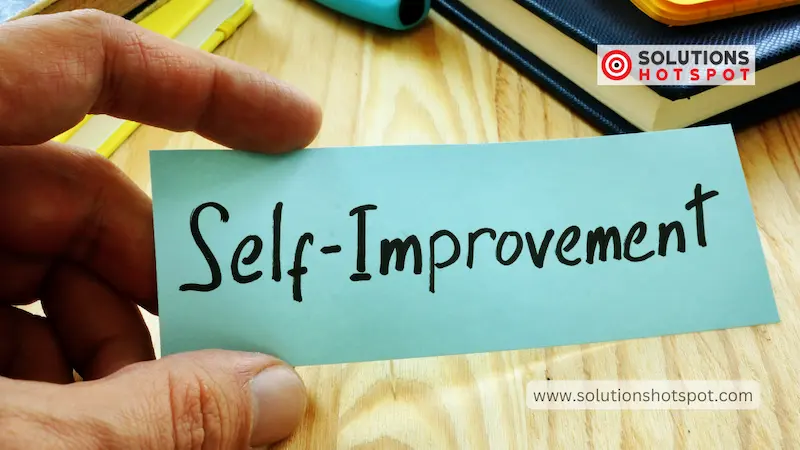Building Confidence and Self-Esteem-A Handy Guide: Self-improvement is a lifelong journey of personal growth and development. It involves enhancing various aspects of oneself to lead a more fulfilling and successful life. In this article, we will explore what self-improvement entails and provide practical insights into improving self-development, self-esteem, and confidence. Let’s dive into the world of self-improvement and discover the key pillars of personal growth.
Also Read: What is Self-Improvement? A Journey to Personal Growth


What is self-improvement? Self-improvement refers to the intentional process of enhancing one’s knowledge, skills, character, and overall well-being. It involves setting goals, seeking personal development, and making positive changes in various areas of life to become a better, more fulfilled individual.
How do I improve my self-development? Improving self-development involves several key steps: a. Self-assessment: Understand your strengths and weaknesses. b. Goal-setting: Define clear, achievable objectives for personal growth. c. Lifelong learning: Continually seek knowledge and acquire new skills. d. Positive mindset: Cultivate a positive attitude towards challenges. e. Self-discipline: Develop the ability to stay committed to your goals.
What are the 5 steps to improve yourself? The five steps to improve yourself include self-awareness, goal-setting, continuous learning, self-discipline, and resilience. Self-awareness is the foundation, as it helps you identify areas that need improvement.
What are the 7 pillars of self-improvement? The seven pillars of self-improvement encompass personal growth, emotional intelligence, resilience, self-confidence, mindfulness, adaptability, and effective communication. Focusing on these pillars can lead to holistic self-improvement.
What are the six elements of self? The six elements of self include physical, emotional, intellectual, social, spiritual, and vocational aspects. Balancing and nurturing each element contributes to overall self-improvement.
What are the 8 pillars of personal development? Personal development encompasses self-awareness, self-management, emotional intelligence, resilience, communication skills, time management, goal-setting, and adaptability. These pillars empower individuals to grow personally and professionally.


What are the 4 aspects of self? The four aspects of self encompass physical, emotional, intellectual, and social dimensions. Nurturing each aspect contributes to a well-rounded self-improvement journey.
What are the 4 four aspects of the self? The four aspects of the self are self-concept, self-esteem, self-efficacy, and self-identity. These aspects influence how individuals perceive and interact with the world around them.
What are the 5 components of self-esteem? The five components of self-esteem include self-worth, self-acceptance, self-confidence, self-respect, and self-love. Building and maintaining these components are essential for a healthy self-esteem.
What are 10 ways to improve self-esteem? Ten ways to improve self-esteem include setting realistic goals, practicing self-compassion, challenging negative self-talk, seeking support, celebrating achievements, embracing self-care, cultivating positive relationships, learning from failures, acknowledging strengths, and prioritizing mental health.
How to improve confidence? Improving confidence involves self-assessment, setting achievable goals, facing fears, learning from setbacks, practicing self-compassion, and seeking support. Confidence grows through positive experiences and self-belief.
What are the 3 C’s of self-esteem? The three C’s of self-esteem are competence, connection, and control. Developing competence in various areas, nurturing meaningful connections, and having a sense of control over one’s life contribute to healthy self-esteem.


What are the 3 types of confidence? The three types of confidence include self-confidence, situational confidence, and global confidence. Self-confidence relates to overall self-belief, situational confidence pertains to specific situations, and global confidence encompasses confidence in various life domains.
What are 6 pillars of self-esteem? The six pillars of self-esteem include self-acceptance, self-responsibility, self-assertiveness, purposeful living, personal integrity, and healthy relationships. These pillars support a strong sense of self-worth.
What are the four types of self-confidence? The four types of self-confidence are interpersonal confidence (confidence in social situations), emotional confidence (confidence in managing emotions), physical confidence (confidence in physical abilities), and intellectual confidence (confidence in intellectual capabilities).
What are the six 6 ways to build your self-confidence? Building self-confidence involves setting achievable goals, visualizing success, practicing self-compassion, facing fears, seeking feedback, and celebrating small victories. Consistent effort in these areas leads to improved self-confidence.
What are the six steps in building self-confidence? The six steps in building self-confidence include self-awareness, self-acceptance, self-improvement, setting goals, facing challenges, and celebrating achievements. These steps create a positive cycle of confidence development.
What are the nine sources of confidence? The nine sources of confidence include self-efficacy, past achievements, positive feedback, self-reflection, self-care, resilience, self-compassion, supportive relationships, and personal growth. These sources collectively contribute to a confident mindset.


What is the key to confidence? The key to confidence is self-belief. Believing in your abilities, setting and achieving goals, and learning from challenges all contribute to building and maintaining confidence.
What inspires confidence? Confidence is inspired by positive experiences, personal growth, overcoming obstacles, supportive relationships, and a strong sense of self-worth. Embracing challenges and striving for continuous improvement also fuel confidence.
What are the main points of confidence? The main points of confidence
Also Read: Best Books on How to Love Yourself
Building Confidence and Self-Esteem-A Handy Guide
FAQ
Q1: How can I overcome the fear of failure?
Challenge your perception of failure, adopting a growth mindset. View failures as learning opportunities, not setbacks. Focus on the process rather than the outcome. Reframe failure as a stepping stone towards success.
Q2: How can I maintain confidence amidst criticism?
Distinguish between constructive and destructive criticism. Value constructive feedback, using it for self-improvement. Evaluate the source of criticism, considering its credibility. Practice self-compassion, reminding yourself of your strengths and worth.
Q3: How can I embrace my imperfections and develop a positive body image?
Challenge societal beauty standards, embracing diversity in body shapes and sizes. Practice self-gratitude, appreciating your body’s strength and resilience. Engage in self-care activities that promote physical and mental well-being.
Q4: How can I balance ambition and self-acceptance?
Set realistic goals, breaking them into smaller steps. Celebrate progress along the way. Practice self-compassion, learning from mistakes and adjusting your approach. Prioritize self-care and maintain a healthy work-life balance.
Q5: How can I cultivate a resilient mindset?
Develop a strong sense of self-belief in your abilities. Embrace a growth mindset, viewing setbacks as learning opportunities. Practice mindfulness to stay grounded and manage stress, maintaining a positive perspective.

